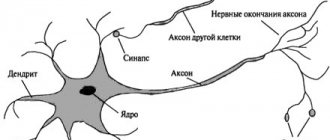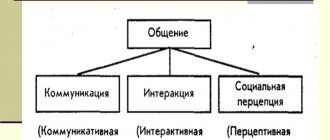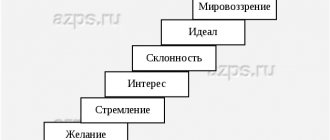Communication is an important process in the life of every person. With the help of it, people share their experiences and thoughts. Information exchange always occurs during joint activities. You can get acquainted with all the diversity of this type of communication only by understanding what the structure of communication is and what its main levels are.
Communication
Structure of communication in psychology
When communicating, the social relationship of people to each other is realized. During the exchange of information, each person is rooted as a full member of society. The concept of “communication” is a complex form of interaction, therefore, in order to understand its essence, it is necessary to study its components:
- communication;
- interaction;
- social perception.
The diagram shows that each part is responsible for one of the sides of communication.
Scheme
Sides of communication
Types of communication in psychology - what they include, its functions
Characterizing the structure of communication, in psychology there are 3 interconnected aspects:
- perceptual;
- interactive;
- communicative.
Each of them has its own characteristics.
The communicative side of communication
The term “communication” originates from the English. communicate, which means “to convey”, “to report”. This type of contact is aimed at exchanging information, which includes:
- feelings;
- emotions;
- values;
- thoughts;
- ideas.
The communication process, according to researcher Harold Lasswell, consists of 5 elements that help information reach the addressee:
- communicator - deals with the transmission of messages;
- speech information or text - what the person to whom the message is intended must learn;
- channel – how the exchange is carried out;
- audience or recipient - the addressee to whom the information is sent;
- effectiveness is the result of assimilation of the received message.
The communicative side largely depends on the subjective information content of the individual, that is, on the characteristics of the person, his degree of awareness about the interlocutor and the topic of the conversation.
Communication side
Important! If a person's knowledge level is low, misunderstandings are likely to occur.
Example 1. A teacher is teaching new material during a social studies lesson. If he communicates with children in a professional language, without simplifying scientific terminology, not a single student will be able to understand the content of the information message.
Example 2. A person who does not know etiquette will not be accepted in a society where everyone tries to act according to the rules. An uncultured person simply will not be understood.
The exchange of information between people can occur through 2 channels:
- Non-verbal - with the help of gestures, facial expressions, signs;
- Verbal - using speech.
According to psychologist Allan Pease, 60-70% of all information is transmitted through brief non-verbal contact.
Perceptual side of communication
Perception, or the perceptual side of communication in psychology, is a form of human interaction that is aimed not only at perceiving and understanding the interlocutor, but also at his acceptance.
Social perception
Additional Information. If 2 people share each other's beliefs, culture and values, affection, friendship or love can develop between them.
Perceptual communication helps you “read” the people around you. By analyzing your interlocutor, you can “see” that he did not tell about himself. If your own perception is misinterpreted, conflict may arise.
Social perception helps:
- Understand yourself. Social interaction with society is a good means of obtaining information about one's own personality. Identifying yourself with the interlocutor helps you consider your own hidden desires, needs and fears.
- Develop emotional interaction, for example, sympathy, friendship, hostility.
- Study your partner. Perception allows us to understand the ethics of other people. With its help, you can find the individuals you need for life and work.
- Organize joint activities with one person or a whole group of people. Thanks to knowledge of the values, motives and attitudes of a partner, it is easier to work with him as a team.
- Develop mutual understanding. Communication based on common views and interests is the key to a good mood and a fruitful exchange of information.
Thanks to perception, a person is able to understand the society in which he lives, as well as build relationships with people using the knowledge gained.
The interactive side of communication
The main focus of the interactive side of communication is building a strategy for subsequent effective communication.
Important! High-quality exchange of information is necessary for people to organize joint activities.
Interactive side
Among the basic principles of building interactive communication, the following four options can be distinguished:
- the presence of common motives and goals;
- high-quality transmission of verbal and non-verbal messages;
- common time and space for joint work;
- presence of coordination of actions.
Despite the fact that all requirements are the same for all persons involved in communication, the behavior of participants may differ from each other. Most often, human interaction is divided into 2 main types:
- Cooperation. This type assumes that participants who have the same goals coordinate and combine their forces to achieve a positive result that will satisfy everyone.
- Competition. With this type of interaction, each participant is interested only in his own success.
In addition to the main types, other behavioral strategies can be found in the psychological literature, for example:
- Compromise is a temporary agreement to achieve partners’ goals in order to maintain relationships and conditional equality.
- Altruism or compliance. A person is able to refuse to achieve his own goals in favor of the desires of his partner.
- Avoidance, which is expressed in ignoring contact and abandoning one’s own goals in order to exclude the gain of another participant.
All aspects of communication that are included in the structure of communication complement each other and are interconnected. Effective contact is only possible when all 3 processes are involved.
Communication structure
There are three interrelated sides of communication: the communicative side of communication consists of the exchange of information between people; the interactive side - in organizing interaction between people: for example, it is necessary to coordinate actions, distribute functions or influence the mood, behavior, beliefs of the interlocutor; the perceptual side of communication is the process of perceiving partners in communication and creating mutual understanding on this basis.
Communication facilities include:
Language is a system of words, phrases and rules for combining them into meaningful statements used for communication. Words and rules for their use are the same for all speakers of that language, which makes communication through the language possible. When I say “table,” I am sure that each of my interlocutors associates this word with the same concept as I do - this objective social meaning of the word can be called a sign of language. But the objective meaning of a word is refracted for a person through the prism of his own activity and already forms its personal, “subjective” meaning, so we do not always understand each other correctly.
Intonation, an emotional expression that can give different meanings to the same sentence.
The facial expression, posture, and gaze of the interlocutor can strengthen, complement or refute the meaning of the sentence.
Gestures as a means of communication can be either general, that is, have a fixed meaning, or expressive, that is, serve to increase the expressive capabilities of speech.
The distance with which interlocutors communicate depends on cultural, national traditions and the degree of trust in the interlocutor.
Dividing the communication structure into levels
Functions of communication in psychology and their brief description
Structural components of communication are divided into levels, each of which allows one to analyze the characteristics of the influence of one person on another, as well as the nature of their communication.
Levels according to A.B. Dobrovich
A.B. Dobrovich divided the structure of human interaction into 7 levels:
- Primitive. He is characterized by easy and simple communication.
- Conventional. The level at which partners are able to build communication on the rules that they themselves have established.
- Manipulative. To obtain benefits, one of the partners may use tricks and tricks.
- Standardized. During communication at this level, partners strive to hide their true motives, goals, desires and feelings.
- Game. Communication is built on sympathy for the partner, the desire to make a pleasant impression on him.
- Business. Communication involves solving any important issues that require mental activity.
- Spiritual. This level is characterized by the presence of mutual interest of partners not only in each other, but also in joint activities. In the course of a common cause, each participant receives moral satisfaction.
It was proposed to allocate 2 times fewer levels by B.F. Lomov:
- Macro level. A person’s relationships with other individuals are built according to social norms, customs and traditions.
- Mesa level. Communication covers only a few substantive topics. Communication at this level can be either reusable or one-time.
- Micro level. Interaction is built only on the basis of short contact: a handshake, a pantomic or facial act, a question and answer.
The micro level in the structure of communication is the foundation underlying all other communications.
Communication between people can be harmonious and complete only if there is a close relationship between non-verbal and verbal signals and the behavioral actions of the participants. The more individuals are focused on quality contact, the more strongly these factors need to be demonstrated.
Communication as information exchange
Communication is defined as a complex, multifaceted process of establishing and developing contacts between people, generated by the needs of joint activities and including the exchange of information, the development of a unified strategy for interaction, perception and understanding of another person. The analytical model of communication by G.M. has received wide recognition. Andreeva
, according to which the structure of any act of communication includes communicative, perceptual and interactive sides.
Let's consider the communicative side of communication
.
The following features of human communication are highlighted
: 1. Communication cannot be considered only as the sending of information by a transmitting system and its reception by another system because, unlike the simple “movement of information” between two devices, here we are dealing with the relationship of two individuals, each of whom is active subject.
2. The possibility of mutual influence of partners on each other through a system of signs. 3. Communicative influence is possible only when the communicator and the recipient have a single or similar system of codification and decodification (they speak the same language). 4. Possibility of communication barriers. Communication is defined as the process of two-way exchange of information leading to mutual understanding. If mutual understanding is not achieved, then communication has failed. The transmission of any information is possible only through sign systems. In a rough division, a distinction is made between verbal and nonverbal communications that use different sign systems. Verbal communication uses human speech, natural sound language, as a sign system, i.e. a system of phonetic signs, including lexical and syntactic principles. Speech is a universal means of communication, since when transmitting information through speech, the meaning of the message is least lost. Speech is the process of communication between people through language. Language is a system of conventional symbols with the help of which combinations of sounds that have a certain meaning and meaning for people are transmitted. There are three types of speech
: 1)
Inner speech is a special type of silent speech activity of a person, characterized by the utmost condensation of grammatical structure and content. It is the main tool of thinking. The thought begins to form in inner speech. Its mechanism was studied by L.S. Vygotsky. This speech is silent, unpronounceable, includes images, and differs from the external degree of linguistic formation. The child first develops external speech and then, based on it, internal speech. 2) External speech . External speech exists in oral and written forms. Oral speech is external, spoken speech perceived by ear. Oral speech has two forms - monologue and dialogic. Written speech is carried out through written signs. 3) An intermediate position between external and internal speech is occupied by egocentric speech - oral speech directed at oneself. It is especially noticeable in preschool children, when they play and talk to themselves during the game. Elements of egocentric speech can also be found in an adult when, while solving a complex problem, he thinks out loud.
Verbal and nonverbal communication
The transmission of any information is possible only through sign systems. In a rough division, a distinction is made between verbal and nonverbal communications that use different sign systems. Verbal communication uses human speech, natural sound language, as a sign system, i.e. a system of phonetic signs, including lexical and syntactic principles. Speech is a universal means of communication, since when transmitting information through speech, the meaning of the message is least lost. Speech
- the main, uniquely human way of communication.
At the same time, we transmit information to each other using not only words, but also many other ways, including facial expressions, gestures, posture, intonation, clothing, even objects around us. Nonverbal communication is interaction between people using non-verbal means, the exchange of nonverbal messages and their interpretation in a given situation. The following types of nonverbal communication are distinguished
: 1.
Paralinguistics - rate of speech, timbre, volume and pitch of voice. 2. Extralinguistics - sighs, coughs, pauses in speech, laughter. 3. Kinesics – gesture, facial expressions, posture, gait, gaze. 4. Takesika - static and dynamic touches of people to each other in the process of communication. 5. Olfactory – taste, smell. 6. Proxemics or spatial psychology - includes such aspects as the distance between interlocutors, the orientation of the body of each interlocutor relative to each other, etc.
Features of nonverbal communication:
| Nonverbal communication | Verbal communication |
| Multisensory nature (carried out with the participation of different sensory systems: hearing, vision, skin-tactile sense, chemoreception, thermoception) | Monosensory nature (carried out with the participation of one sensory system - hearing) |
| Situational (exchange of messages about what is happening “here and now”, within a specific situation, with people entering into direct interaction) | Non-situational (exchange of messages that may exist other than the person transmitting them (for example, in retelling or in the form of text), allow you to inform about missing objects or phenomena) |
| Integrity (a non-verbal message can hardly be decomposed into separate units; their core consists of a variety of movements of the body, face, voice, spatial movements) | Discreteness (the constituent elements of a verbal message (letters, words, sentences) are clearly separated from each other, their relationship is subject to certain rules) |
| Involuntariness (nonverbal behavior is spontaneous, involuntary movements predominate over voluntary ones, unconscious ones over conscious ones) | Arbitrariness (verbal statements are largely conscious, they are easier to analyze, evaluate, understand, control) |
| They learn it themselves (people, as a rule, successfully acquire nonverbal language themselves through observation, copying, and imitation) | They teach specifically (children are taught to speak on purpose; family and society devote a lot of time and effort to this) |
Specifics of professional communication of a modern psychologist
Communication is present in all types of human activity
.
But there are types of work where it turns from a factor accompanying activity, accompanying it, into a cardinal, professionally significant category. In other words, communication no longer acts as a form of everyday human interaction, but as a functional category. Communication in psychological activities is precisely functional and professionally significant. It acts as an instrument of influence, and the usual conditions and functions of communication receive additional “load” here, since they develop from universal human aspects into professional and creative components. Professional communication of a psychologist
can be considered from several positions, each of which defines its own specific point of view and sets a special logic of thinking.
From an outsider's perspective,
communication competence is largely seen as equivalent to professionalism.
In ordinary consciousness, this point of view can be formulated as follows: “If you know how to communicate, you are a good psychologist.” The main requirements of a non-psychologist for the competence of a psychologist in communication come down to at least two: he must “see through people” and be able to achieve his goals, even using psychological tricks, tricks, etc. From the position of a communication partner
the competence of a psychologist in communication often seems to be a rather dangerous weapon .
As a result, suspicions, accusations, and direct attacks arise - a wide arsenal of means of proactive interpersonal psychological defense is used. From the position of the psychologist himself,
his communication can be considered as a tool with which the psychologist works, as one of the tools from the professional arsenal that he must master.
From the perspective of a fellow psychologist,
communication is viewed as a subject of professional assessment.
True, the requirements for communication in this case are dissolved in the technology of professional interaction and are considered as a means of solving professional problems. The procedures and norms of professional communication are best developed in relation to psychological counseling, psychodiagnostics and group trainings. Characteristics of a psychologist's professional communication
:
Sensitivity is the ability to discern more details in the same events than a non-professional can do. Flexibility in means
is the ability to select such means of achieving goals that exactly correspond to the characteristics of the communication situation, while being economical and environmentally friendly.
Purposefulness
is the ability to remember the goal and correlate your actions with it.
In particular, keep the topic of conversation in line with progress towards the intended goal. Insight
is the ability to see the motives of actions, recognize intentions, identify the individual characteristics of a communication partner, etc. That is, master psychodiagnostics without using specifically professional tools.
The ability to take a reflexive position
is the ability to be not only a participant in interaction, a subject of relationships, but also an observer of the process and content. Psychology
Communication can be different, interpersonal, intergroup, and is always generated by the joint activities of people. The structure of communication, considered from the perspective of social psychology, has three sides.
Communicative - at the moment of interaction, information is exchanged and the received fragment is understood. These actions are ensured by a single sign system for the addressee and addressee, the implementation of mutual influence and the establishment of relationships.
Articles on the topic
- Communication etiquette as an important part of communicative activities
- Interaction between family and school - unity of education and training
- Unity and interconnection of communication and activity
- How to communicate with a schizophrenic: features of behavior and conversation
Interactive - carried out between partners at the time of organizing or performing joint work or other activities. The form of communication is complemented by the motives and goals of communication, as well as interaction.
Perceptual - shows the level of perception of one partner by another.
The process of communication is considered fundamental in the life of an individual and the entire society. Its main task is to convey thoughts and experiences to another individual. All aspects of communication are interconnected and can alternate during a dialogue depending on the situation and the level of mutual understanding between the interlocutors.
Communication: structure, functions, basic concepts
One of the generally accepted ones is the appointment of three interrelated aspects or properties in communication - communicative, interactive and perceptual.
The communicative side of communication, or communication in the strict sense of the word, is the exchange of information between communicating persons. The interactive side consists of organizing interaction between communicating people, that is, the exchange of not only knowledge, ideas, but also actions. The perceptual side of communication means the process of perception and cognition of the other communicating partner and the establishment of mutual understanding on this basis.
Communication functions are varied. There are various reasons for their classification.
The information and communication function of communication in a broad sense is the exchange of information or the receipt and transmission of information between interacting persons.
The regulatory-communicative (interactive) function of communication, in contrast to the information function, is to regulate behavior and directly organize the joint activities of people in the process of their interaction.
In the process of communication as interaction, a person can influence motives, goals, programs, decision-making, execution and control of actions, that is, all components of his partner’s activities, including mutual stimulation and behavior correction.
The affective-communicative function of communication is associated with the regulation of the emotional sphere of a person. Communication is the main determining factor in a person’s emotional states. In the conditions of human communication, the entire spectrum of specific human emotions arises and develops: either a merging of emotional states occurs, or their polarization, mutual strengthening or weakening.
The main mechanisms of mutual understanding in the communication process are identification, empathy and reflection.
Reflection in the problem of mutual understanding is a person’s understanding of how he is perceived and understood by his communication partner. During mutual reflection of the participants in communication, “reflection” is a kind of feedback that contributes to the formation of a strategy for the behavior of the subjects of communication and the correction of their understanding of the characteristics of the inner world of another.
Another mechanism of understanding in communication is interpersonal attraction. Attraction is the process of creating a person's perceptual attractiveness, which leads to the formation of interpersonal relationships.
Features of communication processes
In the communicative structure of communication, the main emphasis is on the exchange of information. The interactive part involves the exchange of actions and experiences in them. In this case, not only the transfer of information itself occurs, but also its further development and clarification. People mutually influence each other, but this is only possible if the codification systems of both the human communicator and the recipient coincide.
A side aspect of communication is the emergence of various specific communication barriers.
The main goal of interactive communication is to satisfy needs, as well as implement an idea or a specific plan. Interaction can be different, both positive (cooperation, association, agreement, adaptation) and negative, which leads to obstacles and prevents the construction of a full-fledged system for the exchange of information (competition, opposition, dissociation, conflict).
Perceptual communication is the process of getting to know each other. Interlocutors strive to establish rapport in various ways to improve their communication.
In the process itself, a person acts as a subject and object of interpersonal perception, and this is influenced by various factors:
- gender differences between subjects (women better understand the emotional states of the interlocutor, his strengths and weaknesses, and men are able to quickly determine intelligence);
- temperament (introverts find it easier to assess their interlocutor, while extroverts can more accurately identify the emotional state of their interlocutor);
- age;
- social intelligence (the better developed general and social knowledge, the easier it will be to establish contact and evaluate the interlocutor);
- physical differences;
- health status;
- value orientations.
In addition to these factors, other settings of the communication structure are also taken into account, which previously influenced previous assessments of objects of perception and the level of socio-psychological competence of objects:
- physical appearance (height, weight, skin color, build);
- functional characteristics (age, posture, gait and postures used);
- speech characteristics (facial expressions, movements, body language used, phonetics);
- the relationship between the object of perception and the subject;
The interaction between interlocutors and their willingness to make contact have a direct effect on the process of understanding.
Types of communication barriers
When expressing his opinion or communicating important information, a person hopes that his interlocutors will understand his words correctly.
But this doesn't always happen. There are so-called semantic or communication barriers - psychological obstacles that prevent the understanding of information transmitted between participants. The components of communication include barriers of three types: understanding, socio-psychological differences and relationships. There are several barriers to understanding:
- phonetic - inexpressive, monotonous speech, unclear pronunciation of words, accelerated rhythm, abundance of filler words;
- stylistic - inconsistency of the chosen style with the situation or the state of the interlocutor;
- semantic - differences in the vocabulary of participants, possible misunderstanding due to the polysemy of words;
- logical - when the partner does not see a logical connection between statements or considers some statements absurd.
Social and psychological barriers arise in the case of similar differences between interlocutors. Includes religious, social and professional differences. May lead to the development of a conflict situation.
The relationship barrier depends on the attitude of the participants in the conversation towards the speaker. If his authority is high enough, the barrier will disappear, and all the information said will be learned correctly.
The structure of communication and its division into levels
Communication can occur both at the verbal level and non-verbal, taking into account movements of the eyes, head, and body. Based on the facial expressions, pantomimics and gestures of the speaker, a person often intuitively understands whether the information he is receiving is reliable.
The levels of communication are as follows:
- Manipulative. One of the interlocutors is trying to achieve some benefits, trying to evoke a feeling of pity or simple sympathy in the partner, which influences the decision-making.
- Primitive. One person acts as a communicator and suppresses the others. In this case, other objects act as permanent recipients.
- Higher. At this level, everyone treats each other equally, regardless of various factors.
Communication is a complex process, the meaning of which initially lies precisely in the transfer of information. Evolution has made many adjustments to the methods of communication that humans use almost subconsciously.










